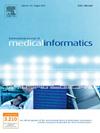Machine learning for predicting outcomes of transcatheter aortic valve implantation: A systematic review
IF 3.7
2区 医学
Q2 COMPUTER SCIENCE, INFORMATION SYSTEMS
International Journal of Medical Informatics
Pub Date : 2025-02-16
DOI:10.1016/j.ijmedinf.2025.105840
引用次数: 0
Abstract
Background
Transcatheter aortic valve implantation (TAVI) therapy has demonstrated its clear benefits such as low invasiveness, to treat aortic stenosis. Despite associated benefits, still post-procedural complications might occur. The severity of these complications depends on pre-existing clinical conditions and patient specific complex anatomical features. Accurate prediction of TAVI outcomes will assist in the precise risk assessment for patients undergoing TAVI. Throughout the past decade, different machine learning (ML) approaches have been utilized to predict outcomes of TAVI. This systematic review aims to assess the application of ML in TAVI for the purpose of outcome prediction.
Methods
Preferred Reporting Items for Systematic Reviews and Meta-Analyses (PRISMA) guideline was adapted for searching the PubMed and Scopus databases on ML use in TAVI outcomes prediction. Once the studies that meet the inclusion criteria were identified, data from these studies were retrieved and were further examined. 17 parameters relevant to TAVI outcomes were carefully identified for assessing the quality of the included studies.
Results
Following the search of the mentioned databases, 78 studies were initially retrieved, and 17 of these studies were included for further assessment. Most of the included studies focused on mortality prediction, utilizing datasets of varying sizes and diverse ML algorithms. The most employed ML algorithms were random forest, logistics regression, and gradient boosting. Among the studied parameters, serum creatinine, age, BMI, hemoglobin, and aortic valve mean gradient were identified as key predictors for TAVI outcomes. These predictors were found to be well aligned with established associations in current literature.
Conclusion
ML presents a promising opportunity for improving the success and safety of TAVI and enhancing patient-centered care. While currently retrospective studies with low generalizability and heterogeneity form the basis of ML TAVI research, future prospective investigations with highly heterogeneous patient TAVI cohorts will be critically important for firmly establishing the applicability of ML in predicting TAVI outcomes.
机器学习预测经导管主动脉瓣植入术结果:系统综述
经导管主动脉瓣植入术(TAVI)治疗主动脉瓣狭窄具有低侵入性等明显的优势。尽管有相关的益处,但仍可能发生术后并发症。这些并发症的严重程度取决于先前存在的临床状况和患者特定的复杂解剖特征。准确预测TAVI的结果将有助于对TAVI患者进行精确的风险评估。在过去的十年中,不同的机器学习(ML)方法被用来预测TAVI的结果。本系统综述旨在评估ML在TAVI中的应用,以预测预后。方法采用PRISMA (Systematic Reviews and meta - analysis)指南检索PubMed和Scopus数据库中ML在TAVI预后预测中的应用。一旦确定符合纳入标准的研究,就从这些研究中检索数据并进一步检查。仔细确定了与TAVI结果相关的17个参数,以评估纳入研究的质量。在检索上述数据库后,最初检索到78项研究,其中17项研究被纳入进一步评估。大多数纳入的研究都集中在死亡率预测上,利用不同大小的数据集和不同的ML算法。最常用的ML算法是随机森林、logistic回归和梯度增强。在研究参数中,血清肌酐、年龄、BMI、血红蛋白和主动脉瓣平均梯度被确定为TAVI结局的关键预测因素。这些预测因子被发现与当前文献中建立的关联很好地一致。结论ml为提高TAVI的成功率和安全性,加强以患者为中心的护理提供了良好的机会。虽然目前具有低通用性和异质性的回顾性研究构成了ML - TAVI研究的基础,但未来具有高度异质性的患者TAVI队列的前瞻性研究对于牢固建立ML预测TAVI结果的适用性至关重要。
本文章由计算机程序翻译,如有差异,请以英文原文为准。
求助全文
约1分钟内获得全文
求助全文
来源期刊

International Journal of Medical Informatics
医学-计算机:信息系统
CiteScore
8.90
自引率
4.10%
发文量
217
审稿时长
42 days
期刊介绍:
International Journal of Medical Informatics provides an international medium for dissemination of original results and interpretative reviews concerning the field of medical informatics. The Journal emphasizes the evaluation of systems in healthcare settings.
The scope of journal covers:
Information systems, including national or international registration systems, hospital information systems, departmental and/or physician''s office systems, document handling systems, electronic medical record systems, standardization, systems integration etc.;
Computer-aided medical decision support systems using heuristic, algorithmic and/or statistical methods as exemplified in decision theory, protocol development, artificial intelligence, etc.
Educational computer based programs pertaining to medical informatics or medicine in general;
Organizational, economic, social, clinical impact, ethical and cost-benefit aspects of IT applications in health care.
 求助内容:
求助内容: 应助结果提醒方式:
应助结果提醒方式:


